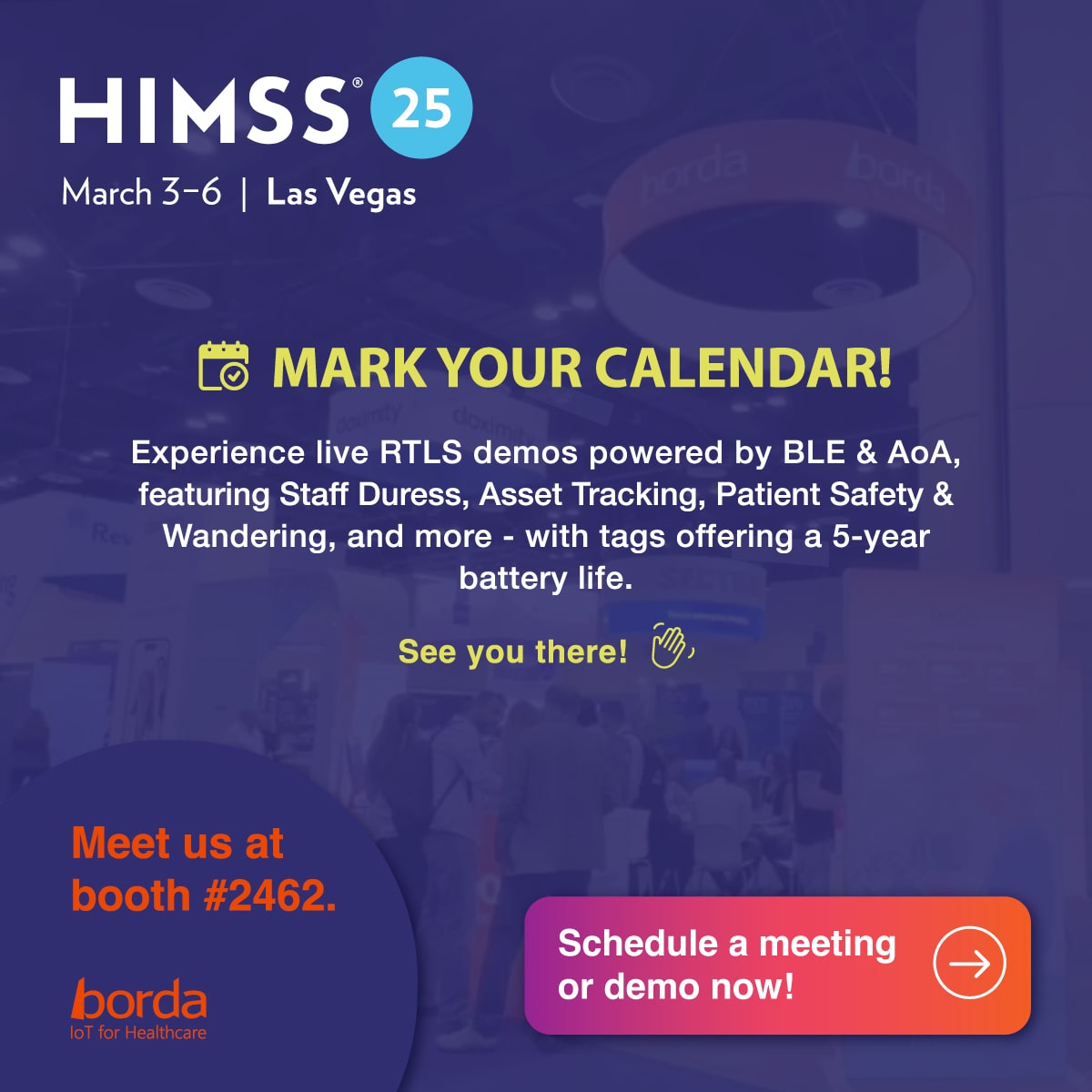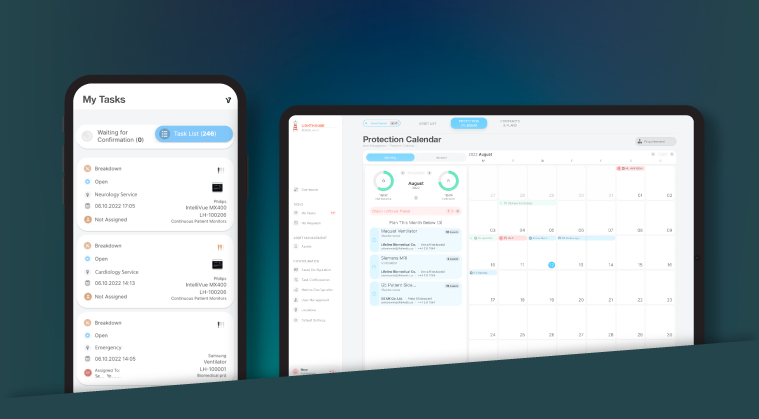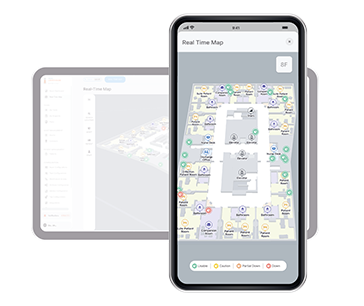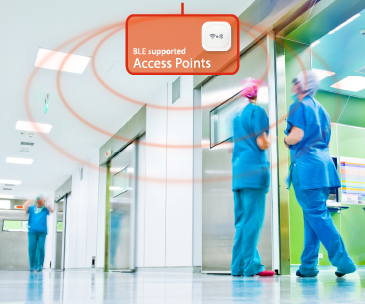
Patient Wandering Prevention and Emergency Nurse Call via Hospital RTLS
Patient Wandering Prevention and Emergency Nurse Call via Hospital RTLS
Patient safety is the heartbeat of any hospital and ensuring that patients are safe during their time in the hospital is a fundamental responsibility of healthcare providers. Every day, healthcare professionals strive to ensure that patients receive the highest quality care while minimizing risks and errors. According to the World Health Organization (WHO), millions of patients are harmed every year due to unsafe healthcare practices, making patient safety a global health concern. Therefore, it’s imperative to continually improve patient safety measures.
Real-Time Location Systems (RTLS) have emerged as a game-changing technology that is revolutionizing patient safety in hospitals. RTLS technology is not just transforming but elevating the very essence of care within the walls of hospitals. Combining hardware and software, RTLS capability enables the real-time tracking of assets, and people within defined areas. Leveraging technologies such as RFID (Radio-Frequency Identification), Wi-Fi, Bluetooth, and GPS, RTLS offers precise, real-time location information. In this blog, we will focus on how to prevent patient wandering and enhance emergency nurse calls which are among the most important topics in patient safety.

How Hospital RTLS Improves Patient Safety and Security
Keeping a Watchful Eye: Patient Wandering Prevention
Patients with dementia or those disoriented due to illness can inadvertently wander into unsafe areas, causing accidents or delays in critical care. Traditional monitoring methods often fall short, but here are the steps where RTLS steps in as the guardian angel of patient safety. By preventing patient wandering, RTLS enhances overall hospital security. It reduces the risk of unauthorized access to certain areas, ensuring that patients remain in safe and controlled environment. For both patients and their families, knowing that there is a system in place to prevent wandering provides peace of mind. It reduces anxiety and improves the overall hospital experience.
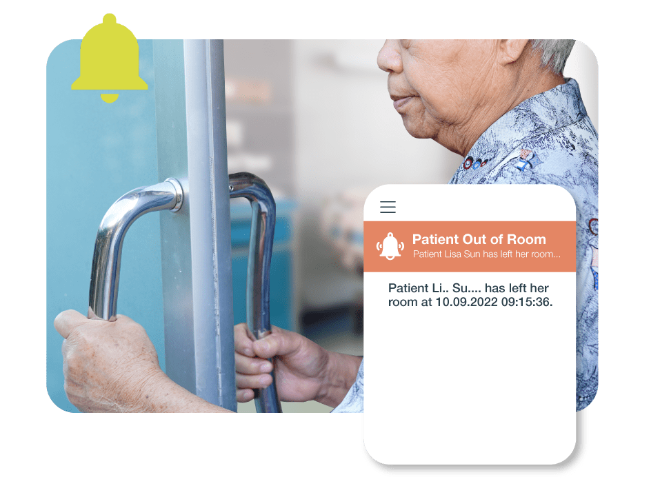
24×7 Constant Monitoring: RTLS employs a network of sensors and tags, typically worn by patients, which continuously transmit their location data to a centralized system. This real-time tracking ensures that the hospital staff knows where each patient is at all times.
Geo-Fencing and Boundaries: Hospital RTLS can define specific areas within the facility as authorized zones. When a patient wearing an RTLS Patient Tag approaches or crosses a predefined boundary, the system triggers alerts. For example, if a dementia patient wearing an RTLS tag approaches an exit door, an alert is generated, allowing staff to intervene.
Immediate Alerts: When a patient’s location strays from the designated safe zones, the RTLS system sends immediate alerts to designated personnel, such as nurses or security staff. These alerts can be in the form of alarms, text messages, or notifications on a central monitoring dashboard.
Quick Response: With the real-time information provided by RTLS, hospital staff can respond swiftly to any wandering incidents. They can locate and assist the wandering patient promptly, preventing them from entering potentially dangerous or restricted areas.
Customized Alerts: Hospital RTLS systems can be configured to issue customized alerts based on the patient’s specific needs and risk level. For instance, a patient with a higher risk of wandering due to cognitive impairment may trigger more urgent alert
Historical Data Analysis: RTLS technology doesn’t just help during wandering incidents; it also provides valuable historical data. Hospitals can analyze this data to identify patterns and potential triggers for patient wandering. This insight can lead to proactive measures to prevent future incidents.
The Voice of the Patient: Emergency Nurse Call System Integration
RTLS doesn’t stop at patient tracking; it seamlessly integrates with emergency nurse call systems, which are the lifeline that connects patients to their caregivers. During a medical emergency or when a patient requires urgent assistance, time is of the essence. RTLS simplifies and accelerates the process. Patients feel more secure knowing that their calls for assistance are being acknowledged promptly. This contributes to a positive patient experience and improves overall satisfaction with their care. Here’s how this technology, when combined with nurse call systems, contributes to patient protection and safety:
Rapid Response to Patient Calls: When patients activate the emergency call system with a simple push of a nurse call button on their wristbands; Patient Tag, the system identifies the patient’s location, enabling nurses to reach them faster than ever before. This allows healthcare providers to respond promptly, ensuring patients receive timely assistance. Whether it’s a request for pain relief or an emergency, reducing response times is critical for patient safety.
Accurate Location Identification: RTLS provides precise location data, so healthcare providers know exactly where the patient is within the hospital room or facility. This accuracy is vital in emergencies, where every second counts.
Prioritizing Responses: Integrated RTLS and nurse call systems can prioritize calls based on the patient’s condition or urgency. For example, a call from a patient in distress might receive a higher priority, ensuring that the most critical cases are addressed first.
Data and Reporting: The integrated system can capture data on response times, call frequencies, and patient needs. This information can be analyzed to identify areas for improvement in patient care and safety.
Asset tracking & management, hand hygiene, patient fall prevention, infection control also helps to achieve patient safety goals in hospitals
RTLS enables hospitals to track the real-time location of equipment such as infusion pumps, defibrillators, and wheelchairs, ensuring that they are always readily available when needed. Additionally, RTLS provides invaluable insights into the movements and interactions of healthcare professionals. This data can be harnessed to optimize staff workflows, ensuring that the right personnel are in the right place at the right time, thus enhancing overall patient care. On the other hand, RTLS can monitor hand hygiene compliance by tracking when and where healthcare workers wash or sanitize their hands. It helps reinforce best practices, reducing the transmission of infections within the hospital environment. Moreover, falls are a major concern in hospitals, often leading to patient injuries. RTLS can monitor patients at a higher risk of falling and swiftly provide assistance, preventing accidents before they occur. Infection control is another critical aspect of patient safety, and RTLS can monitor hand hygiene compliance among healthcare workers, ensuring that proper infection control protocols are followed.
In summary, as hospitals continue to embrace technological RTLS enabled patient safety solutions, the healthcare industry takes significant strides towards a safer and more secure environment for patients and healthcare professionals alike. Patient safety is at the heart of every hospital’s mission, and RTLS is a vital in achieving this goal.

